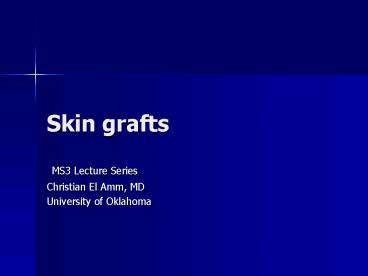Skin grafts - PowerPoint PPT Presentation
1 / 34
Title:
Skin grafts
Description:
Skin grafts. MS3 Lecture Series. Christian El Amm, MD ... buds sprout through the skin graft and connect to pre ... graft: skin cartilage. Current ... – PowerPoint PPT presentation
Number of Views:302
Avg rating:3.0/5.0
Title: Skin grafts
1
Skin grafts
- MS3 Lecture Series
- Christian El Amm, MD
- University of Oklahoma
2
Historical perspective
- First used 2500-3000 BC, (Hindu Tilemaker Caste )
- Re-discovered in 19th century, pinch grafts then
sheet grafts - Now mainstay of burn therapy and cuticle
reconstruction - Hair grafts, melanocyte transplants specialized
transfers - Cultured skin
3
Layers of skin Split thickness
4
Thickness
- Thin STSG 0.008-0.012 inches mostly epithelium,
thin reticular (elastin) - Medium STSG 0.012-0.018 in most commonly used
- Thick STSG 0.018-0.030 in. almost like full
thickness, used in certain application like face,
flexion surfaces where contraction is minimal
5
Full Thickness FTSG
6
Technique
7
Dermatomes
8
Mesher
9
Technique
10
Donor Site areas
11
Donor site appearance
12
Donor site care
- Several techniques
- Occlusive dressing
- Semi Occlusive Dressing
- Absorbent gauze
- Most Common tegaderm 3M, semi occlusive water
vapor permeable, oxygen permeable
13
healing
14
Healing
15
healing
16
Donor site healing
- Basal cell layers in epidermal appendages
de-differentiate into basaloid morphology - Migrate into defect by diapedesis until contact
inhibition - Contact signal beginning re-differentiation into
Stratified Corneal Epithelium layers.
17
Physiology
- 1st 24-48 hours plasmatic imbibition
- Nutrients and oxygen infiltrate through
capillaries lt1mm away (thus the limitation on
thickness) - Fibrin bridges created IMPORTANCE OF COMPRESSIVE
DRESSING
18
Physiology
- 36-48 hours later Inosculation
- Capillary buds sprout through the skin graft and
connect to pre-existing vascular channels and
create new one - Collagen bridges created
19
Physiology
- Neurotization nerve buds from the bed grow into
the graft. - Sensation type (Vibration/fine touch etc) is
that of the bed (e.g. pulp) (Endings???) - Two point discrimination always less than normal
- Sweat glands, erector pilae ???
20
Indications
- Well vascularized, non infected bed
- Large coverage defect not amenable to direct
closure or local flap coverage
21
Contra-indications
- Relative flexion areas, constant shear and
friction - Non vascularized bed, cancer, infection
22
Complications
- Failure, or non-take
- Hyperpigmentation (Thin STSG), Hypopigmentation
(Thick STSG) - Contraction
- Meshed appearance
- Dryness, scaling etc
23
Contraction and Contracture
- Primary contraction due to elastin fibers in
dermis. More pronounced in FTSG. Corrected by
stretching the graft - Secondary contraction, or contracture, more
severe in thinner STSG, more severe if meshed.
May reach 40 of surface. Correction Prolonged
splinting
24
Meshed grafts
- Most common
- Less cosmetic result
- More contracture
- Better take (allows egress of fluids)
- Covers wider surface and irregularities.
25
(No Transcript)
26
(No Transcript)
27
(No Transcript)
28
(No Transcript)
29
Other types of grafts
- Autograft
- Allograft
- Xenograft
- Hair, melanocyte, fat grafts
- Composite graft skincartilage
30
(No Transcript)
31
(No Transcript)
32
(No Transcript)
33
(No Transcript)
34
Current trends
- Cultured Epithelial Autografts A 1 sq cm piece
of skin is cultured in-vitro for keratinocyte
expansion, delivered onto sheets, and given 17-21
days later to cover nearly 90 burn - Dermis replacement Hyaff (hyaluronic scaffold
with cultured dermal fibroblasts), Alloderm
donor cadaver decellularized dermis, Integra etc































